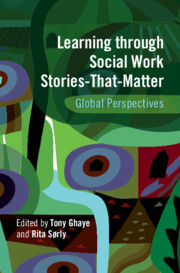Book contents
- Learning through Social Work Stories-that-Matter
- Learning through Social Work Stories-that-Matter
- Copyright page
- Contents
- Meet the Editors
- Meet the Contributors
- Preface
- Acknowledgements
- Introduction
- Part I Storying-to-Learn: How Stories-that-Matter Help Us Appreciate Social Work in Action
- Part II Lenses and Lessons
- Chapter 22 From Punitive Measures to Comprehensive Services
- Chapter 23 Learning from a Pasifika Perspective
- Chapter 24 “I Was So Tired of All the Words”
- Chapter 25 What Next?
- Index
- References
Chapter 22 - From Punitive Measures to Comprehensive Services
A Reflection on the Evolution of Social Work Practices in Tanzania
from Part II - Lenses and Lessons
Published online by Cambridge University Press: 28 August 2025
- Learning through Social Work Stories-that-Matter
- Learning through Social Work Stories-that-Matter
- Copyright page
- Contents
- Meet the Editors
- Meet the Contributors
- Preface
- Acknowledgements
- Introduction
- Part I Storying-to-Learn: How Stories-that-Matter Help Us Appreciate Social Work in Action
- Part II Lenses and Lessons
- Chapter 22 From Punitive Measures to Comprehensive Services
- Chapter 23 Learning from a Pasifika Perspective
- Chapter 24 “I Was So Tired of All the Words”
- Chapter 25 What Next?
- Index
- References
Summary
1. How can the social work profession in Tanzania continue to improve the well-being of people and promote social justice? 2.There is a need to encourage and support social workers on several levels in Tanzania. What issues of human rights are related to this task? 3. How can social workers living outside Tanzania support colleagues working in the region?
Information
- Type
- Chapter
- Information
- Learning through Social Work Stories-That-MatterGlobal Perspectives, pp. 313 - 330Publisher: Cambridge University PressPrint publication year: 2025
References
Accessibility standard: Inaccessible, or known limited accessibility
Why this information is here
This section outlines the accessibility features of this content - including support for screen readers, full keyboard navigation and high-contrast display options. This may not be relevant for you.Accessibility Information
Content Navigation
Allows you to navigate directly to chapters, sections, or non‐text items through a linked table of contents, reducing the need for extensive scrolling.
Provides an interactive index, letting you go straight to where a term or subject appears in the text without manual searching.
Reading Order & Textual Equivalents
You will encounter all content (including footnotes, captions, etc.) in a clear, sequential flow, making it easier to follow with assistive tools like screen readers.
You get concise descriptions (for images, charts, or media clips), ensuring you do not miss crucial information when visual or audio elements are not accessible.
You get more than just short alt text: you have comprehensive text equivalents, transcripts, captions, or audio descriptions for substantial non‐text content, which is especially helpful for complex visuals or multimedia.
Visual Accessibility
You will still understand key ideas or prompts without relying solely on colour, which is especially helpful if you have colour vision deficiencies.
You benefit from high‐contrast text, which improves legibility if you have low vision or if you are reading in less‐than‐ideal lighting conditions.
